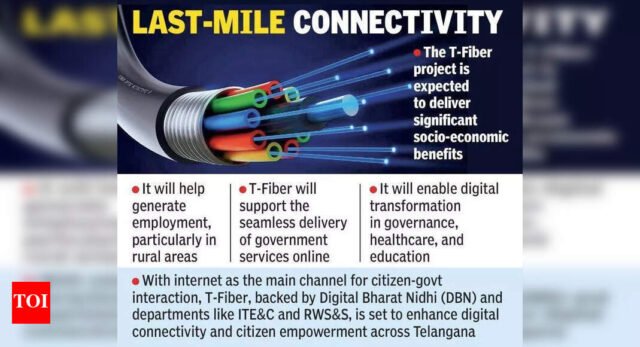Hyderabad: Chief minister A Revanth Reddy on Monday directed officials to submit a comprehensive report on the progress of the T-Fiber project, including a detailed action plan to provide internet services to every household and village.He emphasised that the action plan should aim to deliver improved services to the public through T-Fiber. CM instructed officials to include in the report the expenditure incurred so far, the funds required for completion, sources of funding, and the steps to be taken to ensure the success of the programme.During a review meeting on the T-Fiber project held at his residence, Revanth also directed that notices be issued to the contracting companies that executed the works. “Seek a report from them on how the work was carried out. The number of employees in each company and their roles must also be reviewed,” he said.The T-Fiber project aims to connect every household, govt institution, and private enterprise in Telangana through optical fibre, delivering high-speed internet and enabling inclusive digital growth.Network to span 33 distsThe govt of Telangana is making significant progress in expanding broadband infrastructure under the BharatNet project. As part of this effort, the state has launched the T-Fiber initiative to extend broadband connectivity to the household level, ensuring that every citizen benefits from the digital revolution. A dedicated special purpose vehicle (SPV), Telangana Fiber Grid Corporation, has been established to oversee the rollout of optical fibre and network infrastructure across the state.T-Fiber envisions delivering Fibre-to-the-Home/Enterprise (FTTH/FTTE) connectivity to over 90 lakh households and more than one lakh public and private enterprises, govt offices, and institutions across Telangana. The network will cover 10 Zones (33 Districts), 589 Mandals, and 12,769 Grama Panchayats, deploying a robust end-to-end fibre infrastructure right up to the last mile.To optimise resources, T-Fiber will utilise existing infrastructure such as Right of Way (RoW), trenching, and ducting developed under the prestigious Mission Bhagiratha programme. Optical fibre cables are being laid along the mapped water pipeline routes, enabling faster and more cost-effective implementation. A layered network topology has been designed to ensure high-quality service delivery. The T-Fiber network will support internet speeds of 400–500 Mbps for households and 20 Mbps to 1 Gbps for institutions and enterprises, depending on demand and service requirements.Digital Bharat NidhiThe progress of the T-Fiber project has been significantly supported by the Digital Bharat Nidhi (DBN), formerly known as the Universal Service Obligation Fund (USOF). Operated under the Ministry of Communications, govt of India, DBN has played a key role in advancing fibre connectivity across the country.Telangana’s state-led model of BharatNet is closely aligned with DBN’s objectives of universal broadband coverage. With its technical, financial, and policy-level support, DBN has facilitated key project approvals, monitored service level agreements (SLAs), and coordinated Right of Way (ROW) and forest clearances. As per Union Budget announcements and DBN communications, broadband connectivity will also be extended to all govt secondary schools and primary health centres, further expanding the scope and impact of the T-Fiber initiative in the state.






